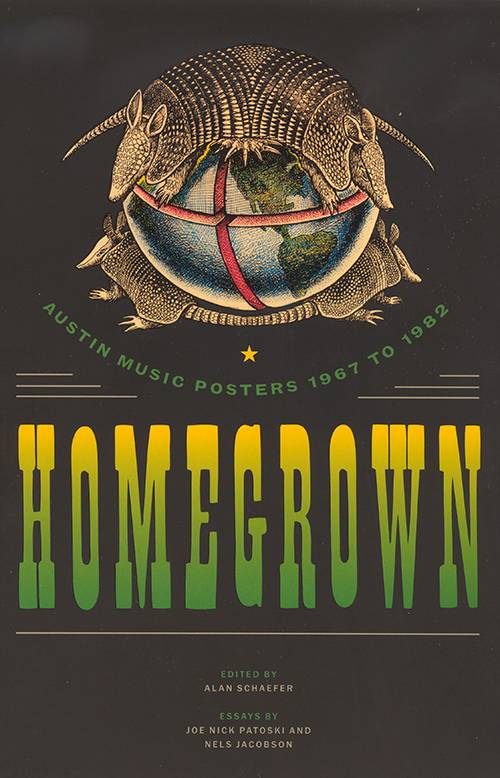Going to the Show

Homegrown: Austin Music Posters, 1967 to 1982
edited by Alan Schaefer
Austin: University of Texas Press, 2015
168 pp. $29.95 paper
Reviewed by
Travis Stimeling
In a 1975 essay in the John Edwards Memorial Foundation Quarterly, folklorist Archie Green turned his attention to Austin’s “cosmic cowboy,” a figure he described as a “fusion of contradictory cultural modes.” Interrogating the ways that Austin’s progressive country musicians and audiences merged countercultural ideals with the symbolism associated with Anglo-Texan cowboys, Green analyzed visual representations of the Austin music scene, including concert posters by Austin mainstay Micael Priest, who told Green that he “desired to bring his dual worlds together” in his art. Green’s decision to turn to concert posters was not a matter of methodological preference, although much of Green’s work indicates he was enthralled by the visual culture associated with American vernacular music. Rather, as Homegrown: Austin Music Posters, 1967 to 1982 demonstrates, the concert posters that adorned record store and head shop windows, telephone poles, and other public spaces were near-constant reminders of the city’s vibrant—and remarkably diverse—music scene and served as dense symbolic representations of the scene’s complexity. Collecting over one hundred twenty posters by more than two dozen artists, Homegrown: Austin Music Posters, 1967 to 1982 stands as a significant and much-needed tribute to the intimate relationship between Austin’s musical and visual communities.
Two prefatory essays situate Austin’s visual culture within the already well-documented history of music-making in the city. Longtime Austin music chronicler, promoter, and occasional poster artist Joe Nick Patoski offers a detailed essay documenting a concert poster tradition stretching from Stephen F. Austin’s broadside entreaties to potential Texan colonists to the height of the city’s punk movement. Patoski is quick to point out that, as early as the mid-1960s, concert posters “were considered art, worthy of collecting,” and “the people who created the posters were regarded as serious artists whose visuals enhanced listening to music…” Thus the posters of Gilbert Shelton and Jim Franklin can be seen not simply as ancillary representations of an emerging musical community, but as significant cultural forces in their own right. Poster artist Nels Jacobson (known in the art world as “Jagmo”) provides detailed insights into the techniques and visual influences that can be seen in Austin’s poster aesthetics, which will certainly make Homegrown an attractive book for contemporary poster artists. Also of interest is Jacobson’s discussion of the ragtag printing companies that ultimately created these stunning posters; one quickly gets the sense of the economic and cultural impact that the music and art worlds had on Austin during the late 1960s and 1970s.
Of course, the centerpiece of Homegrown is a series of one hundred twenty-two color plates depicting the visual aesthetics of Austin’s music scene during its first maturity. Jim Franklin’s poster for a Lightnin’ Hopkins performance at the Vulcan Gas Company, for instance, reveals his remarkable sensitivity to the challenges faced by African American musicians during the heyday of Jim Crow, as an electric hot plate stands in for Hopkins because “black traveling blues performers often had to bring their own provisions for cooking while on the road” in the segregated South. Another Franklin poster for an August 12, 1969, performance by Mother Earth and Shiva’s Headband plays with Apollo 8 astronaut William Anders’s Earthrise, offering a playful pun on the headlining band’s name. Ken Featherston’s 1974 poster for the Marshall Tucker Band’s Armadillo World Headquarters concert depicts the “cosmic cowboy” character as a long-haired cowboy leaping over a crescent moon on the back of his faithful steed. Kerry Awn’s black-and-white calendars for the Soap Creek Saloon, also serve as valuable documents of Austin music iconography and important reminders of the Austin scene’s diversity. The do-it-yourself aesthetic of Austin’s punk scene, which centered around Raul’s, is also represented here in posters by Randy “Biscuit” Turner, Jesse Sublett, and Jagmo.
Homegrown: Austin Music Posters 1967 to 1982 will be significant to anyone curious in the development of Austin’s music and art scenes and the aesthetics and history of concert posters. The book is well organized, the accompanying essays are insightful and clearly written, and the posters included in this collection represent significant trends and artists. One laments the fact that the book is not longer, as some of the artists included here (including especially those from the punk era) are represented with one or two examples, but such additions would have undoubtedly added considerable production costs. Even with that caveat, Homegrown: Austin Music Posters 1967 to 1982 is a major contribution to our understanding of Austin’s creative community and should be a valuable resource to a wide audience of readers.
Travis D. Stimeling is assistant professor of music history at West Virginia University. He is the editor of The Country Music Reader (Oxford University Press, 2014) and the author of Cosmic Cowboys and New Hicks: The Countercultural Sounds of Austin’s Progressive Country Music Scene (Oxford University Press, 2011).
